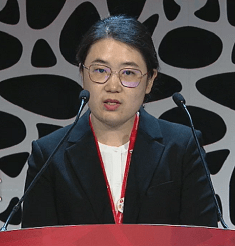
New data on intravenous tenecteplase indicate that it can achieve comparable efficacy and safety to alteplase in treating stroke—and, as such, may be used as an alternative to alteplase for acute ischaemic stroke patients within 4.5 hours of symptom onset.
This was the prevailing message delivered by Shuya Li (Capital Medical University, Beijing, China) in her presentation of the TRACE II trial at the 2023 International Stroke Conference (ISC; 8–10 February, Dallas, USA).
Li began by highlighting previous clinical trials that have indicated 0.25mg/kg of tenecteplase could have comparable effectiveness and safety to 0.9mg/kg of alteplase in acute ischaemic stroke, including the Phase 2 ATTEST study and, more recently, the Phase 3 AcT study. In an effort to build on this body of evidence, Li and her colleagues assessed the newer generation intravenous thrombolysis (IVT) drug, tenecteplase, versus alteplase, which is a more well-established and widely used thrombolytic candidate in stroke care.
They did this via a Phase 3, non-inferiority, multicentre, prospective randomised controlled trial—TRACE II—in which acute ischaemic stroke patients received either 0.25mg/kg of tenecteplase (intervention group) or 0.9mg/kg of alteplase (control group) less than 4.5 hours from the onset of their symptoms.
Li and colleagues’ primary efficacy endpoint was a score of 0–1 on the modified Rankin Scale (mRS) at 90 days, while secondary outcome measures included mRS 0–2, ordinal distribution of mRS and quality of life (EQ-5D) scores at 90 days, as well as short-term National Institutes of Health Stroke Scale (NIHSS) scores. Safety endpoints included short- and long-term intracranial haemorrhages (ICHs), and overall mortality and (serious) adverse events within 90 days.
Between 12 June 2021 and 29 May 2022, a total of 1,430 IVT-eligible ischaemic stroke patients were enrolled at 53 clinical sites across China. Following randomisation, 710 were allocated to tenecteplase and 707 were allocated to alteplase for the trial’s modified intention-to-treat (MITT) analysis, while 671 and 642 patients, respectively, were available for the per-protocol analysis.
Reporting efficacy outcomes from TRACE II, Li informed the ISC audience that 62% of patients in the tenecteplase group achieved an mRS score of 0–1 at 90 days, compared to 58% of patients in the alteplase group. As such, the trial met its primary efficacy outcome in the MITT analysis, demonstrating non-inferiority—but not superiority—of tenecteplase versus alteplase.
Li also stated there was no significant difference between the two groups relating to any of the trial’s secondary efficacy outcomes, and an analysis of prespecified subgroups in both the MITT and per-protocol patient populations further supported the non-inferiority of tenecteplase.
No significant differences were found regarding the prespecified safety outcomes either, with a low rate (2%) of symptomatic ICH at 36 hours and 90 days in both groups, as well as 46 (7%) and 35 (5%) deaths, and 116 (16%) and 107 (15%) serious adverse events, respectively, in the tenecteplase and alteplase groups.
Owing to the non-inferior efficacy of tenecteplase versus alteplase, and the similar safety profiles between the two drugs in TRACE II, and Li concluded that intravenous tenecteplase may be used as an alternative to alteplase in patients who present with acute ischaemic stroke during the early time window (<4.5 hours).
These findings have since been published in The Lancet by Li and the rest of the TRACE II investigators—including lead author Yongjun Wang (Capital Medical University, Beijing, China).













